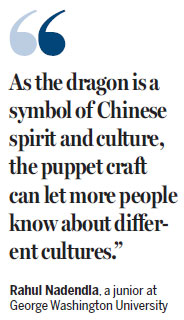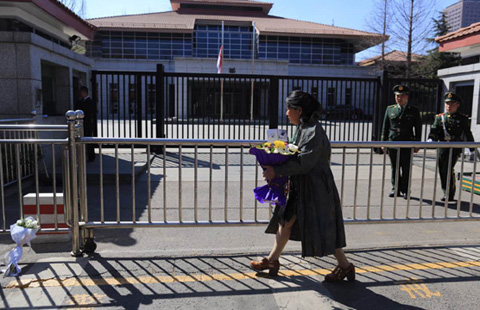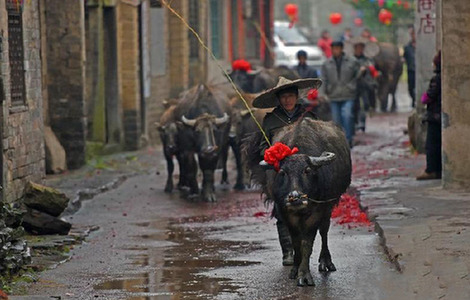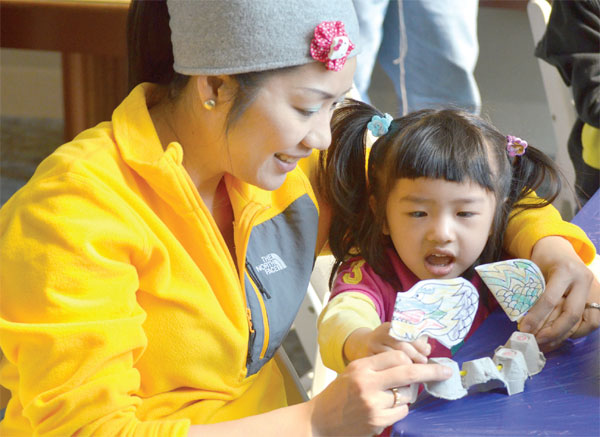Kites of Asia soar at Smithsonian
Updated: 2015-03-23 11:13
By Hua Shengdun in Washington(China Daily USA)
|
|||||||||
|
Evelyn Yang (right), 3, plays the Chinese dragon puppet she just crafted with her mother (right) at the Kites of Asia family day at the Smithsonian National Air and Space Museum in Washington on March 21. [Sheng Yang / for China Daily] |
For Christine Mueller, a first-generation American-born Chinese mother, the dragon puppet craft show in the capital's museum stirred thoughts of her family's China origins.
Coming all the way from Oregon, Mueller brought her two children to the Smithsonian Air and Space Museum in Washington on March 21 for the first Kites of Asia Family Day.
"I've brought them here because I hope my children can be more exposed to Chinese culture," said Mueller, whose parents immigrated to the US from Beijing 40 years ago. "My son pointed to the Chinese puppet craft display as soon as he entered the museum."
"I love the dragon because it is colorful," said her son Kian, 8, who crafted a Chinese dragon puppet under the guidance of volunteers.
In addition to Chinese dragon puppet making, the annual family day featured other traditional Asian crafts, including Japanese cherry blossom drawing and Indonesian flying leaf kites.
Rahul Nadendla, a junior at George Washington University, volunteered at the dragon craft station. 
"As the dragon is a symbol of Chinese spirit and culture, the puppet craft can let more people know about different cultures," Nadendla said. "I am personally quite interested in this."
Nadendla said the Smithsonian Institution, the world's largest museum and research complex that organized the Asian culture event, got its first kite models from China in 1876, following their display at the Philadelphia Centennial Exposition. The kites from China then inspired Orville and Wilber Wright to design their first full-size, piloted glider in 1890.
Isabella Mensilla, another volunteer from GW, said the dragon kite was like a bridge between the people of China and the US.
"Throngs of kids came here today for the puppet making," said Mensilla, who helped children color their dragons.
Chinrang Yang, a researcher at the National Institutes of Health, said he was going to send his daughter to a Chinese language school this fall at the age of 4 and the Chinese arts in the museum could be her first exposure to traditional Chinese culture.
"A lot of Chinese friends in the US bought Mandarin textbooks, and we are also considering teaching my kids Chinese," said Yang, who came to the US from Taiwan in 1992. "When I saw the notifications online, I decided to bring them here."
"It's important to preserve Chinese culture within our family," he said.
Sheng Yang in Washington contributed to this story.
-
 Dressed to thrill
Dressed to thrill 
 Antitrust policy 'treats all fairly'
Antitrust policy 'treats all fairly'
 Top 10 young Chinese entrepreneurs defining the future
Top 10 young Chinese entrepreneurs defining the future
 Singapore Embassy in Beijing mourns Lee Kuan Yew
Singapore Embassy in Beijing mourns Lee Kuan Yew
 China joins legendary flower show
China joins legendary flower show
 Monks perform tea-picking ritual in Hangzhou
Monks perform tea-picking ritual in Hangzhou
 Singapore founding father Lee Kuan Yew
Singapore founding father Lee Kuan Yew
 5 things you may not know about the Spring Equinox
5 things you may not know about the Spring Equinox
Most Viewed
Editor's Picks

|

|

|

|

|

|
Today's Top News
Kites of Asia soar at Smithsonian
Beijing artist gives back to opera
Lee remembered as 'old friend' of Chinese people
Texas Republican Cruz announces presidential bid
Fictional TV presidents more popular than Obama - poll
Funding of China-backed bank will be open to other countries
Six Western economies apply to join AIIB
US urged to honor pledge
US Weekly

|

|









